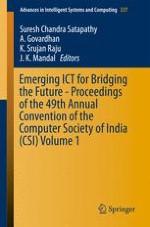2015 | Book
Emerging ICT for Bridging the Future - Proceedings of the 49th Annual Convention of the Computer Society of India (CSI) Volume 1
Editors: Suresh Chandra Satapathy, A. Govardhan, K. Srujan Raju, J. K. Mandal
Publisher: Springer International Publishing
Book Series : Advances in Intelligent Systems and Computing
